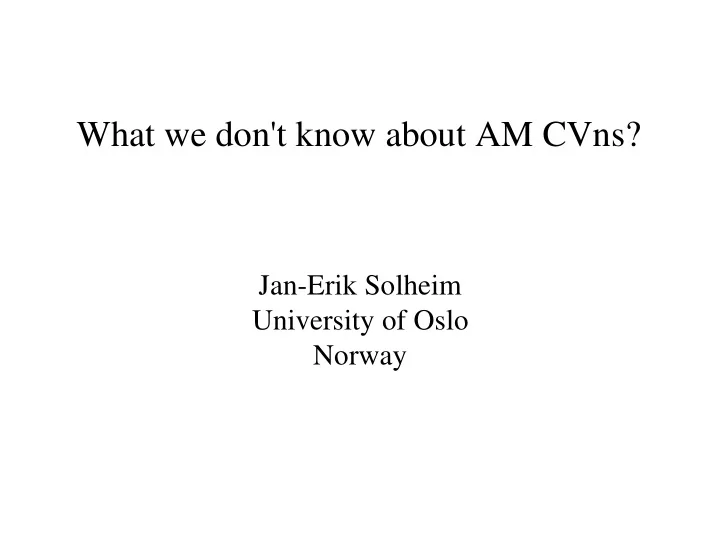

What we don't know about AM CVns? Jan-Erik Solheim University of Oslo Norway
Some questions about AM CVns
Fundamental properties – Ultrashort (binary periods) ● 5-65 minutes – Helium rich spectra ● (No trace of Hydrogen) or He/H >10 5 – Double Degenerate systems ● Sencondary: degenerate or semi-degenerate
Some basic questions ● What are AM Cvn's? – What defines an AM CVn object? – Where do they come from? – Where do they go? ● What do they look like? – Can we produce a direct image? – Or rely on models ? – Or just guess?
Complicated past – exiting future:
Mass transfer versus Period Nelemans, 2005
Accretion rates, disc instabilities, Mass-Radius relation for donor Secondary mass-radius relations: ZS: cold Zapolsky-Salpeter WD; Espaillat et al., 2005 SKH: semi-degenerate Savonije, de Kool &Van den Heuvel; TF: semi-degenerate Tutukov & Fedorova
What does an AM CVn star look like?
Can we observe something like this?
The first “picture” t h e Faulkner, Flannery, Warner 1972
SPH simulations showed precessing non circular disc Simpson & Wood 1998
SPH simulations gave shape of light curve pulse Observed: Simpson & Wood 1998
Shape of disc + inclination = harmonics of superhump frequency NON-Cicular shape ● 0 85 of disc with spiral arms 30 Harmonics of superhump ● frequency – Higher amplitudes at 60 90 higher angles – Mixed with harmonics of 75 orbital period at exteme angels Wood & Simpson 1995
Objects with disc have harmonics in their light curves (P su or P orb ):
AM CVn harmonic structure of superhump period h1 h2 h3 h4 h5 Solheim et al 1998
Size of system in 10 4 km
How big is AM CVn? ● Linear size – distance between mass centers: 160 000 km – disc diameter: 200 000 km – donor diameter: 80 000 km – System diameter: 280 000 km – (The planet Jupiter diameter: 150 000 km) ● At one parsec: 3 mas (milli arc seconds)
How big are AM CVns on the sky? Object distance size (\mu as) w/shell GP Com 75 35 ? HP Lib 200 15 ? CR Boo 340 10 ? V803 Cen 350 10 ? AM CVn 600 4,5 ? CP Eri 800 4 ? Can we expect to see shells of size 10 – 100 mas?
Can the planned GRAVITY instrument on ESO VLT be used for imaging AM CVns? spatial resolution 4 milliarc seconds infrared wavefront sensing down to mK > 10; internal fringe tracking down to mK > 10; multiple baseline narrow angle astrometry with 10 microarcsec accuracy for UT operations; interferometric imaging of faint objects with mK > 19 in 1 hour observing time.
Doppler tomography proves non circular disc – varies in shape with superhump period Roelofs et al. 2006
The Central object (spike) is “ seen “ in velocity space (AM CVn) Roeloefs et al 2006
First detection of accreting star CP Eri STIS spectrum He/H ~ 10 3 ? Sion et al 2006
Why can't we “observe” the donor star? Ulla 1998
Why is the donor star not seen? Is it very cold?
Or is the donor star irradiated to T disc ? BB disc + WD BB disc + WD + donor
The first Carbon rich AM CVn or the first pulsating DQV-star ? SDSS J1426+5752 g = 19.2 P1 = 417,66 s + harmonics Montgomery et al, 2008 the blue edge possible DQ pulsator
The first Carbon rich AM CVn or the first pulsating DQV-star ? SDSS J1426+57 (1,4) Harmonics => pulse shape => AM CVn
Comparison between AM CVn and a multiperiodic WD pulsator
AM CVn pulse shape Solheim et al. 1998
Flickering = sign of mass transfer AM CVn 1991 SDSS J1426+5752 smoothed light curve (dt~45s)
Summary questions There is wind, circumbinary matter, outflows, .. can we make images as ● spectacular as for the planetary nebulae? What does the secondary look like, why no direct observations? ● The Roche lobe, and equation of balance between gravitational angular ● momentum loss and mass loss is all we have – can we thrust this equation? What about pulsations - why not observed? -- the temperature of the ● accretor is right, theory tells what to expect, have we observed in the right way? Why do we find only two AM CVns in continuous high state (AM CVn and ● HL Lib)? --They are both around 14 mag. Why don't we have any between mag 14 and 20? SDSS J142625.71+575218.3 is it a Carbon AM CVn or pulsating DQ star? ● CP Eri --> the first example of a hybrid AM CVn-other proofs needed? ●
Recommend
More recommend